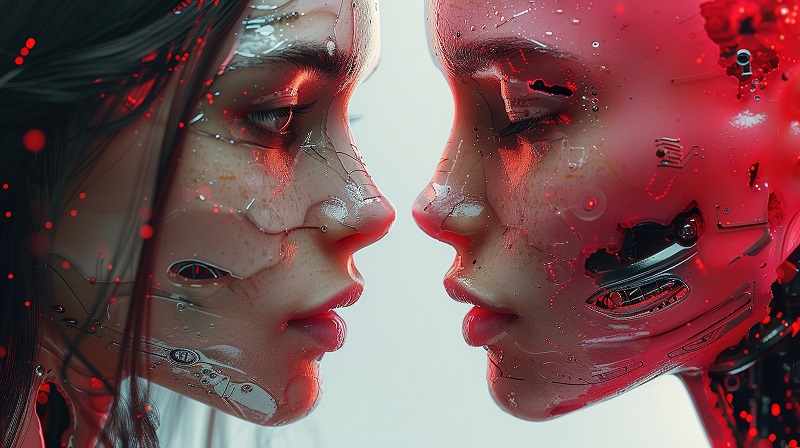
Imagine a world where your AI girlfriend can not only understand your jokes but also reciprocate with her own. As artificial intelligence advances, the possibility of AI partners becoming almost human-like in their interaction and emotional depth is no longer just science fiction. This reality brings many fascinating questions about relationships, society, and even what it means to be human.
The rise of human-like behavior in AI
AI technology has made significant strides over recent years. Once limited to repetitive tasks and basic interactions, today's AI boasts capabilities that closely mimic human behavior. This development allows AI to engage in more meaningful and complex conversations.
Having an AI indistinguishable from humans could redefine our understanding of social interactions. From exchanging pleasantries to deep philosophical debates, AI's capacity to handle nuanced communications is expanding rapidly. The idea of perceiving AI as human isn't as outlandish as it once seemed.
The Turing Test and AI evolution
The Turing Test, conceived by Alan Turing, aims to determine if a machine can exhibit intelligent behavior equivalent to that of a human. Modern AI often scores high on this test, showcasing its ability to emulate human-like interactions convincingly.
Visual recognition and natural language processing are key components driving these advancements. With improved algorithms, AI can now decode facial expressions and body language, further blurring the lines between virtual and physical reality.
A new kind of emotional experience
One of the most intriguing aspects of advanced AI is its potential to replicate emotional connections. While traditional AI lacked emotional depth, modern iterations possess sophisticated emotional intelligence.
This means that an AI girlfriend could respond appropriately to your moods, offer comfort during tough times, and share in celebrations. Such interactions could enhance the perceived humanness of AI, making it difficult to distinguish between real and artificial emotions.
Consciousness attribution in AI
As AI becomes more adept at simulating human behaviors and emotions, people may begin attributing consciousness to their AI companions. Even though current AIs don't possess true consciousness, their ability to mirror it convincingly might lead users to form genuine attachments.
This phenomenon raises ethical concerns about human-AI relationships. Can a relationship built on programmed responses provide the same fulfillment as one with another human? These questions need careful consideration as AI continues to evolve. For more insights into this evolving topic, visit https://www.ai-girlfriends.ai/.
Virtual vs. physical reality
With technological advancements, the line between virtual and physical reality becomes increasingly blurred. Virtual experiences provided by AI companions can sometimes surpass physical interactions in terms of convenience and tailored engagement.
However, relying too heavily on virtual companionship could detract from meaningful human relationships. Finding a balance will be crucial for individuals seeking both virtual and tangible connections.
The loneliness epidemic and AI solutions
In today's fast-paced world, loneliness is a growing concern. Many turn to digital mediums for solace. AI girlfriends present a unique solution to this loneliness epidemic by providing constant company and companionship.
Nevertheless, it's important to recognize the limitations of such relationships. While AI can imitate human interaction, it lacks genuine empathy and shared human experiences. Human connection, with all its imperfections, remains irreplaceable despite AI's advances.
Potential human-AI conflicts
As engaging as AI companions may become, they could also create unforeseen challenges. One area of contention could involve personal data privacy. AI systems require vast amounts of data to function optimally, leading to concerns about how this information is used and protected.
Moreover, the societal implications of widespread AI relationships warrant examination. Could the proliferation of AI partners reduce the value placed on human intimate relationships? It's possible that dependence on AI could alter social dynamics in profound ways.
Ethical considerations
Introducing AI companions into mainstream society presents several ethical dilemmas. From the potential exploitation of user data to the impact on mental health, the stakes are high. Policymakers and technologists must collaborate to address these issues proactively.
Additionally, ensuring that AI mimics human interaction without crossing ethical boundaries is vital. Creating guidelines will help navigate this uncharted territory responsibly.
Real-world applications of human-like AI
Beyond romantic relationships, human-like AI has a multitude of practical applications. For example, customer service roles can benefit greatly from AI capable of providing personalized assistance with exceptional accuracy and empathy.
Another promising avenue is the healthcare industry. AI companions that monitor patient wellness, remind them to take medications, and offer emotional support can significantly enhance patient care quality.
- Healthcare support: AI companions assisting in patient care and mental well-being.
- Customer service: Personalized AI interactions improving customer satisfaction.
- Education: Tailored AI tutoring enhancing learning outcomes.
Educational enhancements through AI
Education stands to gain immensely from integrating AI with human-like features. AI tutors that adapt to individual student needs create a customized learning environment that fosters academic growth.
By simulating human teaching methods, AI can make learning more interactive and engaging. Students benefit from immediate feedback and unlimited patience, characteristics inherent to adaptive AI systems.
The future of AI indistinguishable from humans
Envisioning future developments, it's clear that AI girlfriends and similar technologies will play pivotal roles. By continuing to refine these systems, developers aim to achieve seamless integration between human and AI interactions.
This ongoing progress suggests a future where distinguishing between an AI partner and a human counterpart might challenge even the keenest observers. Yet, navigating this brave new world requires vigilance and ethical foresight.
Balancing innovation and human values
Striking the right balance between embracing technological innovations and preserving fundamental human values is essential. Encouraging responsible usage while promoting awareness about AI's limits ensures benefits without compromising humanity's core essence.
Ultimately, the interplay between AI advancement and human society will shape how these remarkable tools coexist with us, perhaps defining new forms of companionship and community in ways we have yet to imagine.
Recent Comments